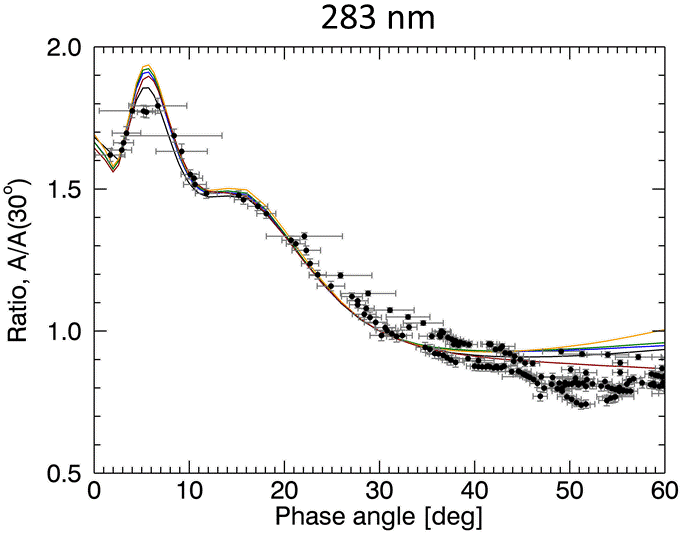Scattering properties of the Venusian clouds in the ultraviolet range
Venus is covered by a thick layer of clouds. What we can see in the visible range is reflected solar light from these clouds, whose top altitude is about 70 km above the surface. It is similar in the ultraviolet (UV) range, and the UV Imager (UVI) on board Akatsuki can detect reflected solar light from the clouds. This reflected solar light is not randomly distributed, but has certain directional preference in its intensity depending on a size of aerosols. Especially, when the Sun is behind of the Akatsuki's camera, and Venus is in front of the camera, so all of three are aligned on a straight line (= zero degree phase angle), then an interesting phenomena occurs: 'glory'. This shows an intensity peak near a point of zero degree phase angle. Glory on Venus was reported in 2014, and UVI has confirmed its observation at 283 and 365 nm channels. In addition, this is the first time to analyze glory at 283 nm in the history of Venus observations. Figure 1 shows an assemblage of four images taken during about 24 hours on May 5-6 2016 at the 283 nm channel. These images are lined up with phase angle that is an angle of Sun-Venus-UVI. Even though there are dark markings owing to UV absorbers (SO2), brighter feature is apparent near the zero degree phase angle, between 4 and 8 degree phase angles. Observed intensity decreases quickly as phase angle increases up to 50 degree (see Figure 2). We analyzed such behaviors in UV images, and the results show that the mean size of cloud aerosols is around 1.26 µm in radius. This is comparable to previous studies. We also estimated the abundance of SO2 that causes dark markings in Figure 1, as 80-400 ppbv near cloud top level by fitting simulated phase angle dependences as shown in Figure 2. As a further study, we will retrieve more accurate of SO2 abundance near cloud top level, as well as characters of UV albedo using the 283 and 365 nm channels of UVI.
These research results are reported in Lee et al., "Scattering Properties of the Venusian Clouds Observed by the UV Imager on board Akatsuki", The Astronomical Journal, 154:44(16pp), 2017 August. (URL)
Figure 1. Albedo images of Venus observed by the UV Imager on board Akatsuki (283 nm).
 Figure 2. Phase angle dependence of observed and modeled albedo at 283 nm. Black dots are observed data and solid color lines are simulations using various atmospheric conditions, including various SO2 abundance from 80 to 400 ppbv near the cloud top level.
Figure 2. Phase angle dependence of observed and modeled albedo at 283 nm. Black dots are observed data and solid color lines are simulations using various atmospheric conditions, including various SO2 abundance from 80 to 400 ppbv near the cloud top level.




